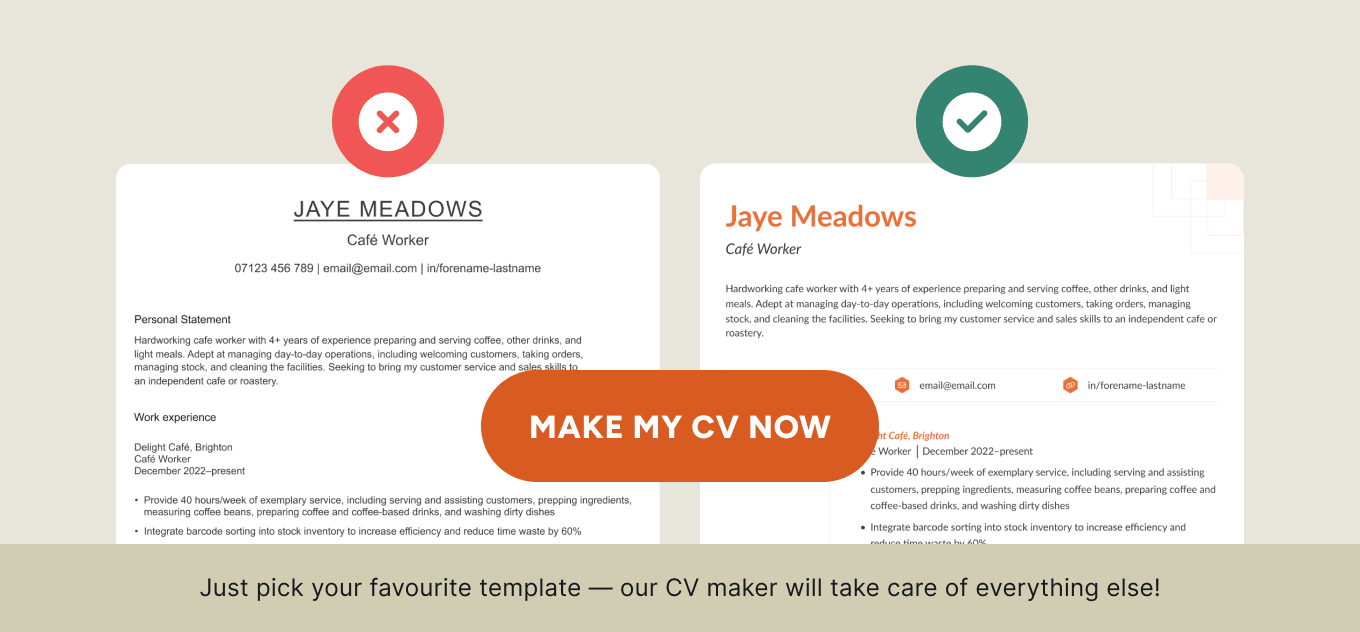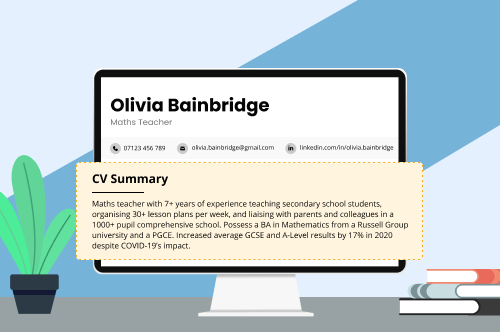3 English CV examples
Here are three English CV examples that you can download for Microsoft Word and fill in with your own information:
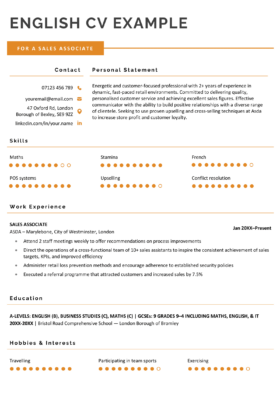
English CV Example



English CV Sample
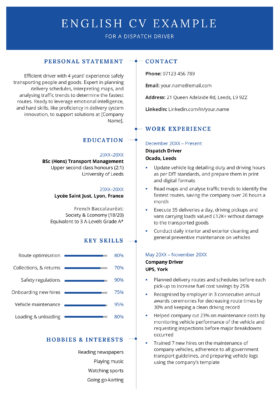


English CV Template
And here they are in full-size versions:
1. English CV example for the retail sector
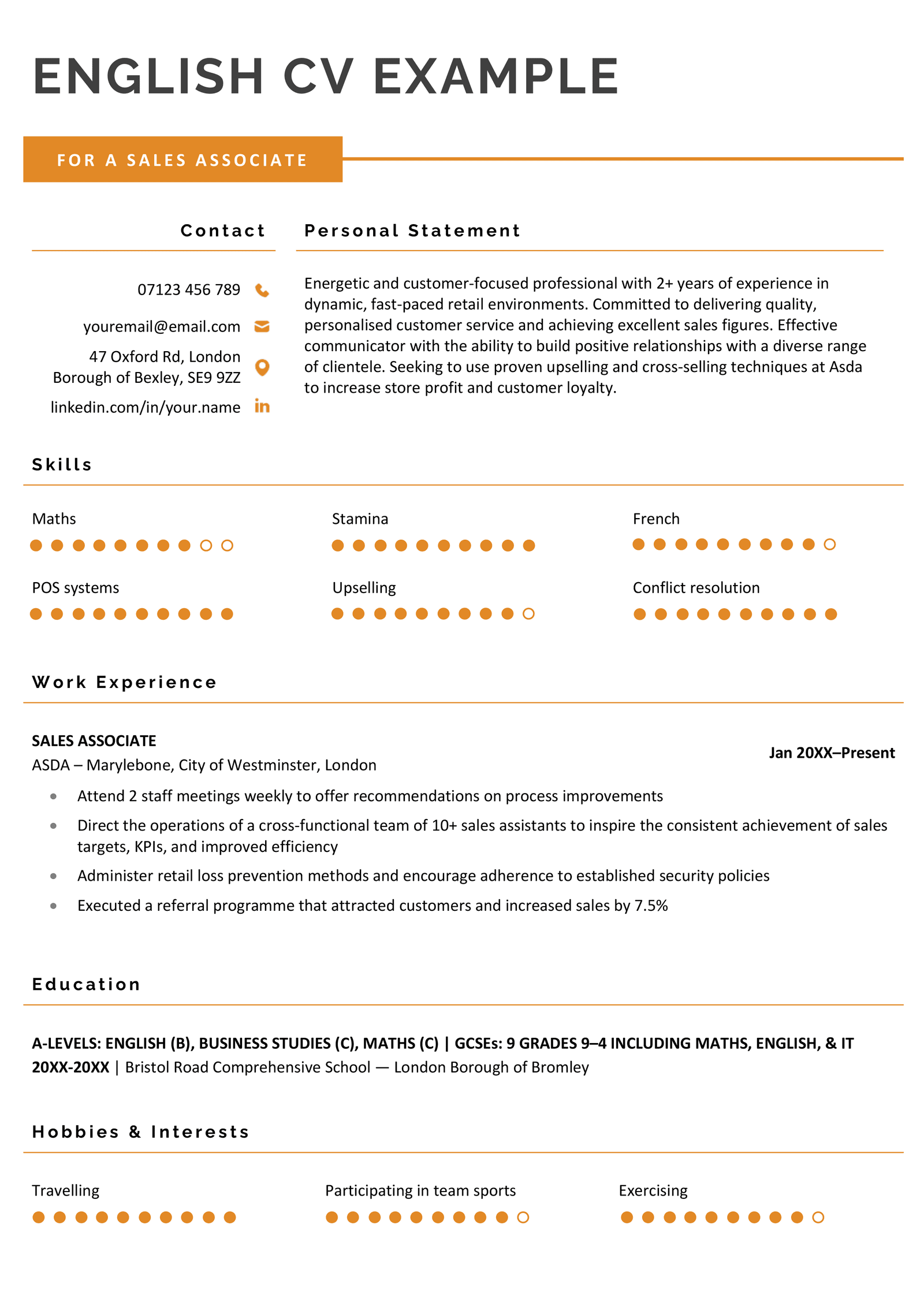

Use This Design
Why this is a good English CV
2. English CV sample for care jobs
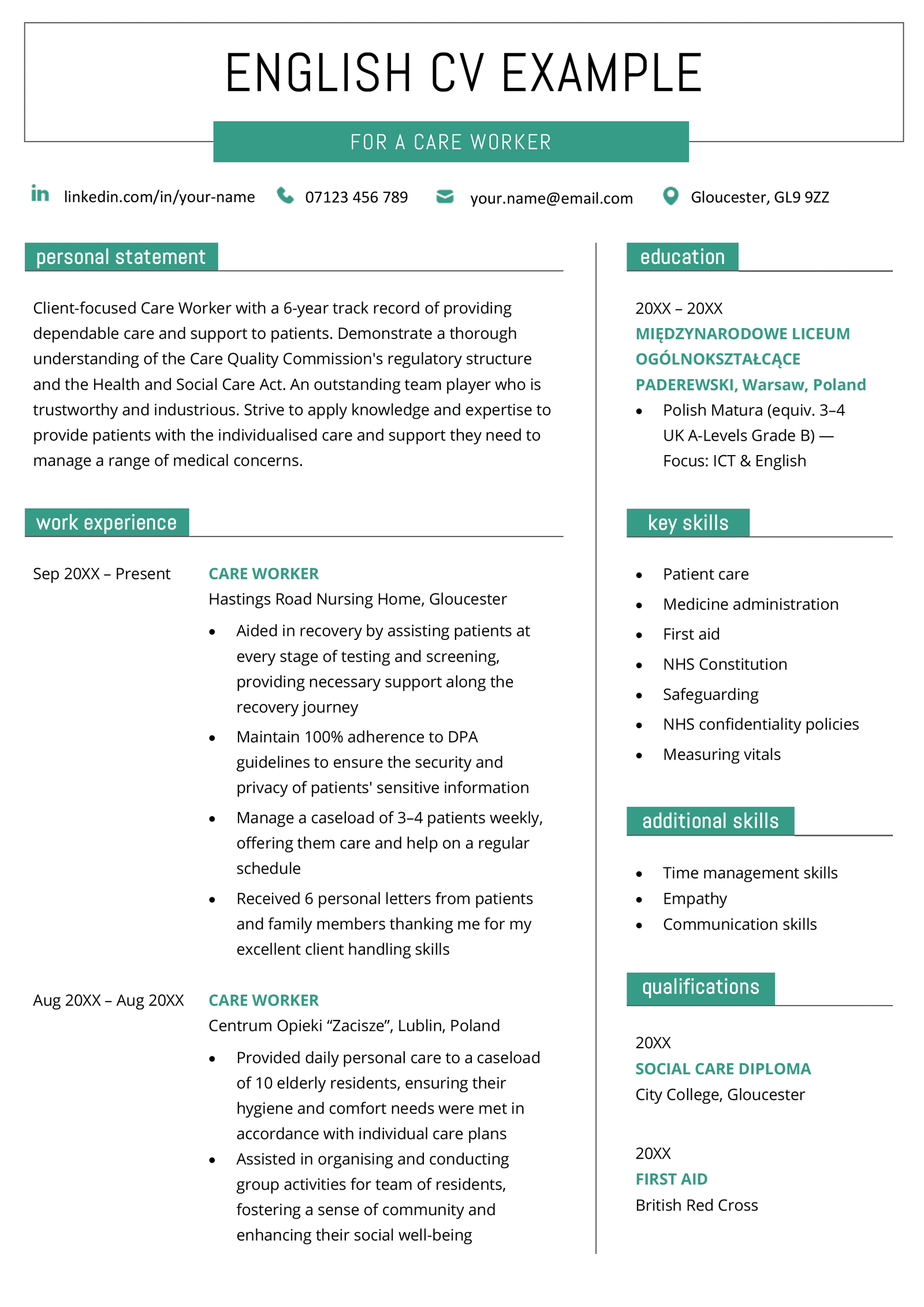

Use This Design
Why this is a good English CV
3. English CV template for delivery roles
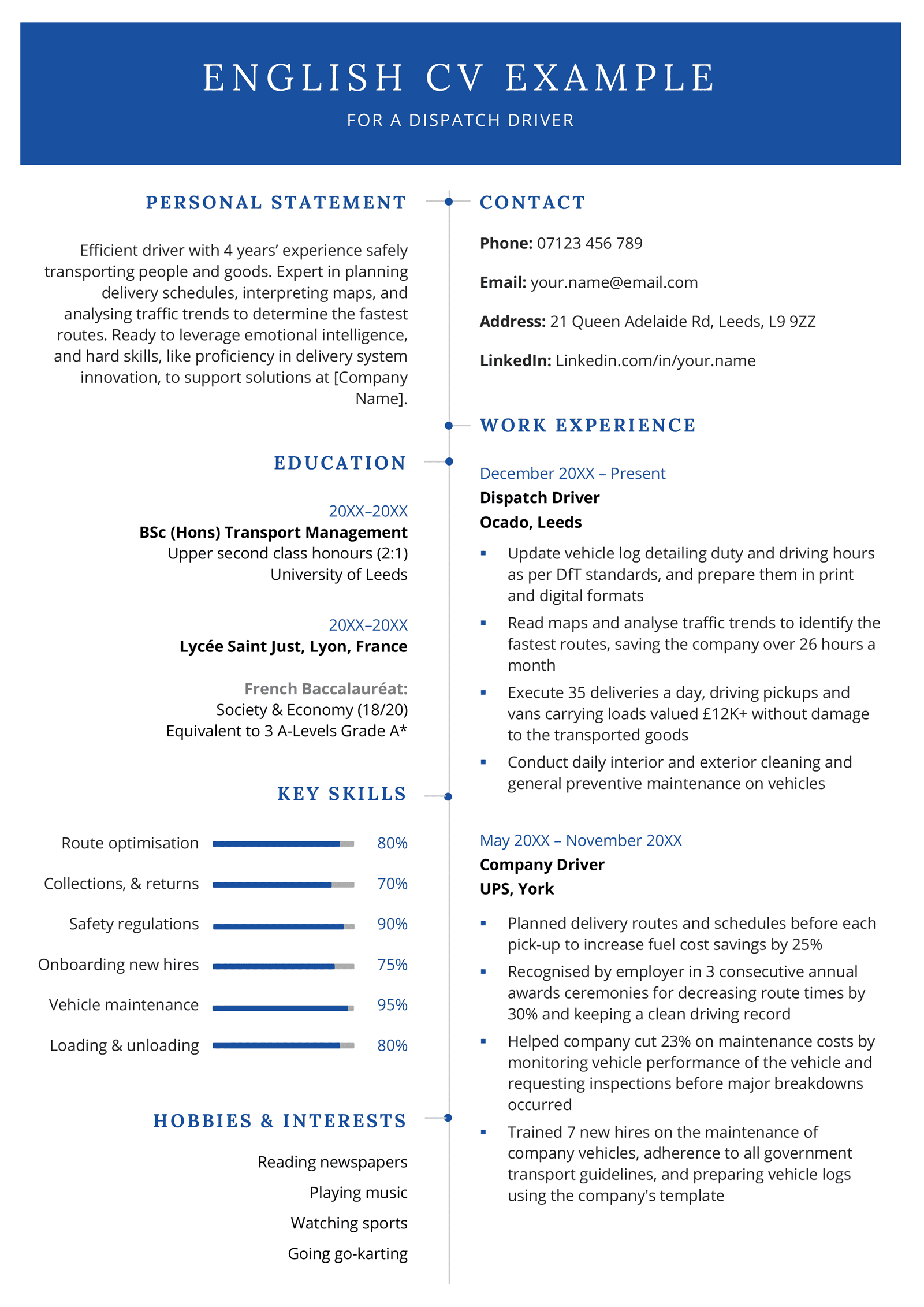

Use This Design
Why this is a good English CV
In addition to having correct local formatting, these English CV templates have a clean, scannable design that makes them perfect for your application.
If you don’t like how these CVs look, download another free CV template — or look at industry-specific CV examples to get some more ideas.
How to make a CV in English (2 ways)
There are two ways to make a CV (curriculum vitae) in English. You can either:
- get professional help by creating a CV using an online CV builder
- learn how to write a good CV yourself from scratch
The best method for you depends on how much time you have, your confidence in your English ability, and whether you know how to format a CV manually.
1. Use a UK CV maker
Using an online CV maker is the most convenient option for making a CV. Good CV makers automatically set up your CV layout based on your chosen design and adjust font sizes as necessary.
To fill out your CV, you can pick pre-written bullet points and skills, ensuring your CV is grammatically correct no matter your level of English.
And if you’re short on time, it should take only minutes to create a CV using an online CV maker.
2. Write your English CV yourself
If your English is fluent and you have some spare time, you can try writing your CV yourself.
If formatting your CV seems hard, download a CV template online. Your layout will be set up already, so you can focus on what you want to write.
Here are some tips for writing your English CV:
- Use British English for jobs in the UK, Ireland, Australia, and New Zealand. Use American English for jobs in the US and Canada (ensure your spell checker is set up properly).
- Add your country’s dialling code to your phone number (e.g., +33 for France) if you don’t have a local number.
- Make your CV 2 pages long, the standard length in the UK (but if you’re a university lecturer or a senior executive, use as many pages as necessary).
- Don’t add your postal address to your CV if you live outside the country. For example, including a Munich address when you’re applying for a job in Manchester could harm your chances if the recruiting manager wants to find someone quickly.
- Don’t include too many personal details on an English CV — for instance, your date of birth, nationality, marital status, height, weight, religion, and National Insurance Number. But you can mention if you have the right to work in the UK.
- Get a native speaker to proofread your CV no matter your level of English because there may be typos or small errors.
- Use 2.5 cm margins and a body CV font size between 10.5 and 12.
If you want to dive into the details of writing a CV, we go through how to make each section of a CV below.
English CVs: section by section
Here’s how each section of an English CV should look:
1. CV header
Top your English CV with a good-looking header:


2. CV personal profile
Then, include a CV personal profile summarising the highlights of your career.


3. Work history section
For each previous job, include your job title, the company name and location, the dates you worked there, and 3–4 bullet points that show what you achieved in the role:
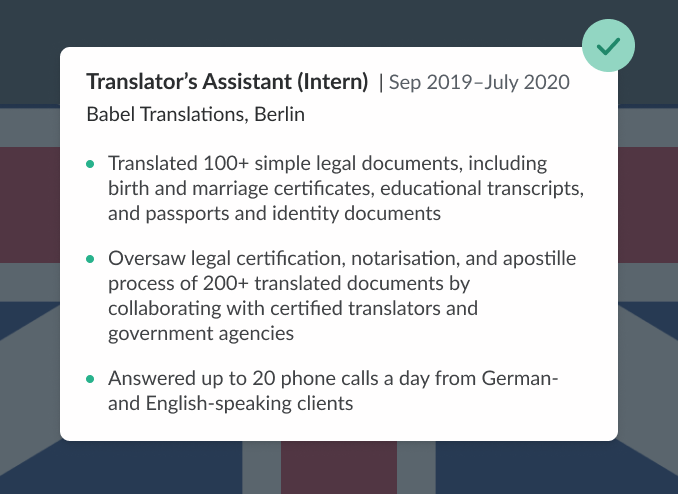

4. Education section
An English CV’s education section includes any degrees you’ve done (master’s, bachelor’s etc.) and secondary school education:


5. Skills list
List your skills on your CV — particularly the ones from the job advert.
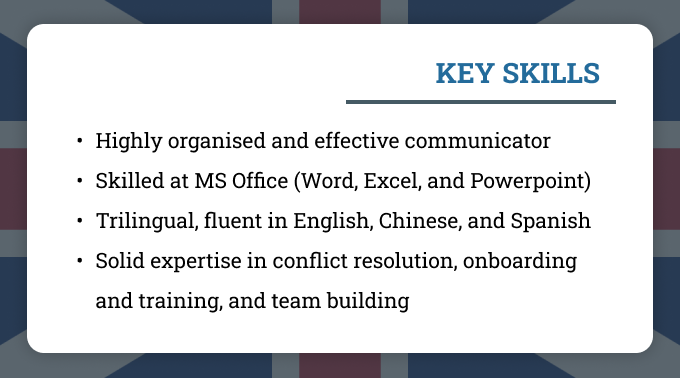

6. Hobbies & interests
When you write a CV in English, it’s normal to describe your hobbies and interests outside of work like this:
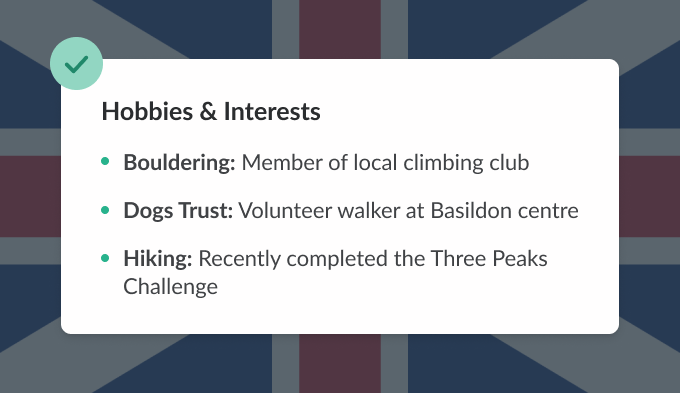

Employers in the UK expect to receive a cover letter with your CV. So learn how to write a good cover letter by looking at cover letter examples in your industry. Happy job hunting!
English CV examples
Here are some CV examples in English that newcomers to the UK can look at to get some ideas for their own CVs:
- CV example for a part-time job
- CV example for a UK internship
- CV example for a first job
- Volunteer CV example
- School leaver CV example
- CV example for a UK apprenticeship
Check out more examples of English CVs for specific jobs.
How to write a CV in English (native language guides)
If you’d like to learn how to write a CV in English in your own language, we might have what you’re looking for:
- Comment faire un CV en anglais (for French speakers)
- Jak napisać CV po angielsku (for Polish speakers)
Common questions about English CVs
Have unanswered questions about writing a CV in English? Here are expert answers to four of the most frequent queries about making a CV for a job in England and the rest of the UK:
1. Is a British CV the same as a resume?
No, a British CV is not the same as a resume. A resume is a one-page CV that you can use to apply for jobs if you’re just out of university.
If you’re applying to work in an English-speaking country that requires a one-page resume instead of a two-page CV, learn the difference between a CV and a resume to make a job-winning application.
2. What is an academic CV in the UK?
An academic CV in the UK is a multi-page document used to apply for jobs in academia. Academic CVs don’t follow the standard CV length of two pages, as extra space is needed for information like:
- publications
- classes taught
- conferences attended
- presentations & posters
3. Is there a CV format for the UK?
This question was asked by a Reddit user.
Unlike the Europass CV format in Europe, there’s no set CV format in English. So you can (and should) fully customise your CV design, layout, and content to best highlight your qualifications and skills, depending on your situation.
For example, if you’re applying to a job in an industry you have no experience in, you can use a skills-based CV that emphasises your abilities over your experience.
But if you have experience related to your target job, ensure your work history is the focus of your CV by placing it right after your personal statement.
4. Should I put a photo on my English CV?
This question was posed on Quora.
No, you shouldn’t put a photo on your CV in the UK and Ireland (and most other English-speaking countries). It’s customary in the UK to keep personal details like your appearance private in the initial stages of a job application.
Also, employers who don’t want to be accused of discriminatory hiring practices often bin applications that have photos.
But there are exceptions to the rule. For instance, if you’re writing an acting CV or hoping to work as a model, you’ll need to submit a headshot and portfolio. In these cases, put a photo on your CV to help the employer decide whether to take a closer look at your portfolio.
You can find well-designed photo CV templates online if you need to add your headshot.

